Moomins and the Finnish Culture
As generalization, Mickey Mouse is instantly recognizable all over the world. The ageless, iconic mouse, in his red shorts and white gloves, is a popular and lovable character and one of Walt Disney’s earliest creations. When Mickey Mouse is mentioned, his friends Goofy, Pluto, Donald Duck and Minnie Mouse are often immediately associated with him. Mickey Mouse and his friends have become a Disney icon that is loved all over the world. However, Moomin and his friends, although popular, is less known outside of his native Finland. If someone were to mention the name ‘Moomin’ outside of Finland what would come to mind? A white hippo-like troll? So, how did this white, hippo-like troll become such a beloved Finnish cultural icon?
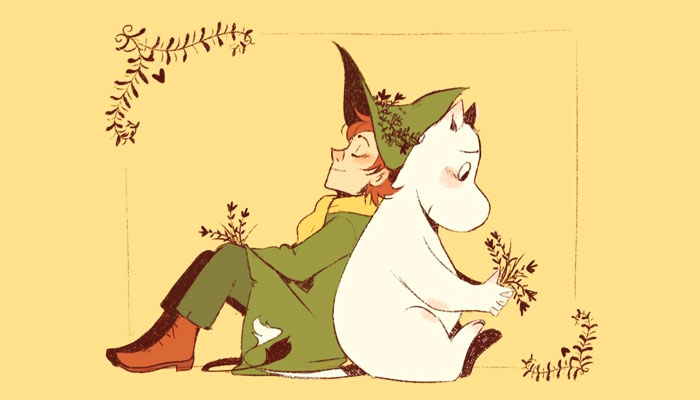
Tove Jansson, a Swedish speaking Finnish illustrator and author, created Moomin and his story as a series of illustrated books and comic strips which were published between 1945 and 1993. Before being animated into show by Japanese producers in 1990 and more recently by Finnish and British producers in 2019, Moomin started to gain popularity through books and later on through comic strips.
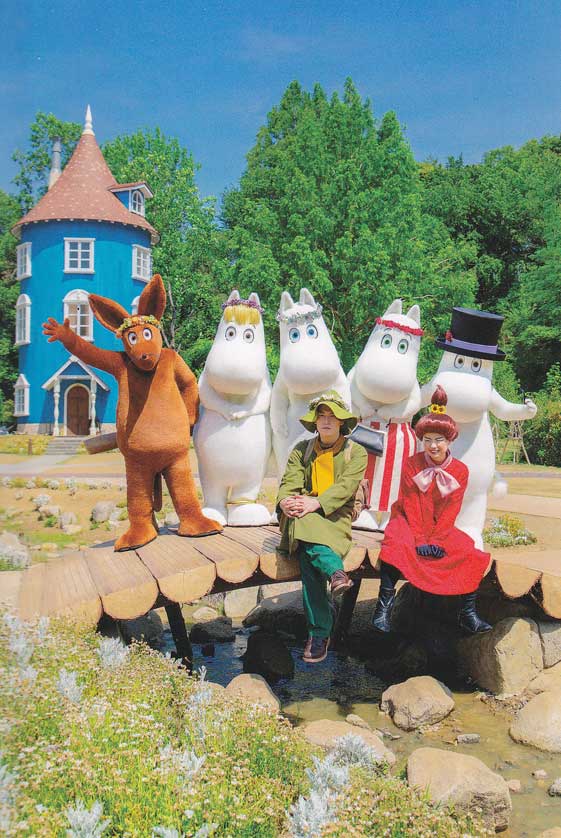
The Moomin story began with Moomin and the Great Flood, Jansson’s first Moomin book written in Swedish in 1945, during the end of World War II. Despite being the first Moomin book, it was the last to be translated into English and is thought to be a prelude to the Moomin stories. The first two Moomin novels were largely unnoticed, but the third Moomin novel, Finn Family Moomintroll was praised in Finland and Sweden in 1948 and became the first Moomin novel to be translated into English in 1950, making an international breakthrough. Moomin’s world popularity also blossomed through the form of comic strips. Moomin’s first appearance in a paper was in a small comic in the children’s section of the the 1947 edition of Nd Tid, a Swedish comic published in Helsinki. Moomin was later introduced to a wider audience when the comics were translated into English in 1954 in a popular London newspaper called Evening News. Since then, Moomin continues to be popular and his stories are read all over the world.
Like Mickey Mouse who has his own theme-park, Disney World, Moomin has a theme-park called Moomin World located in Naantali, Finland. Moomin is an iconic Finnish figure; throughout Finland one can find Moomin ice cream, Moomin designer mugs, Moomin stuffed animals and wooden figures, and even Moomin stores and cafes! Because of Moomin’s popularity in Japan, Moomin fans can visit a theme-park called Moomin Valley Park near Tokyo. One can also visit the several Moomin cafes in Japan.
Introducing the Moomin Characters
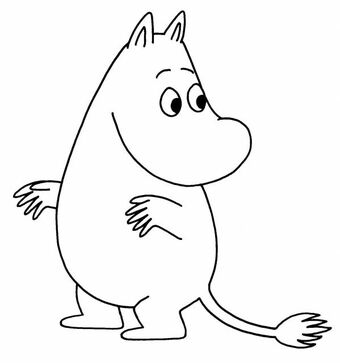
When one sees Moomin, the thought that often comes to mind is what exactly is Moomin? Drawn as a white, round, hippopotamus-like creature with a cow-like tail, a large snout, and cute pointy ears, many wonder what animal could Moomin be? Although Moomin looks like a cross between a cow and a hippo, Moomin is actually a troll. In fact, his full name is Moomintroll.
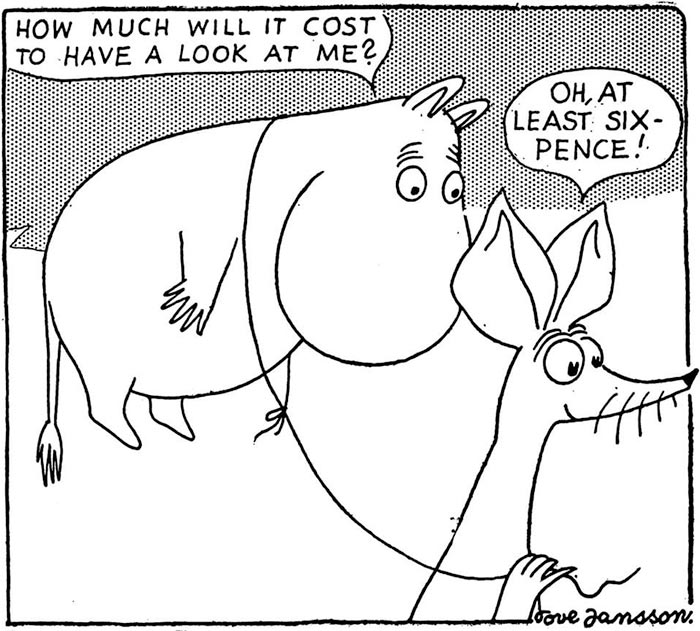
The Moomin story is centred around the various adventures Moomin and his family and friends embark. The family is made up of Moomintroll, the protagonist of the story who is adventurous and always trying to be good, Moominmama, the loving, caring, and generous care-taker of the house, and Moominpapa, the adventurous father who always wears a hat, loves whiskey, and sticks to traditions. The Moomin story would not be complete without Moomin’s interesting friends who often tag along for adventures or spend time in the Moomin family’s home. First, the audience is introduced to Sniff, a lazy, greedy, and cowardly friend, who is practically adopted by the Moomin family. Although he is a faithful friend to Moomin, his priorities are usually food and money. He often aims to get rich, but is never successful. Second is Little My, a little girl who is naughty, brave, and spunky, who also gets adopted by the Moomin family for a period of time. Little My is a sassy character who enjoys doing mean things to others on purpose. Another key feature of Little My is her stubbornness and ability to win over arguments. Little My, although small in stature, is fiercely independent and finds excitement in untidiness.
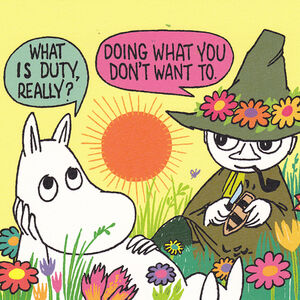
“The main thing in life is to know your own mind.”
Tove Jansson, Snufkin
Another prominent character is Snufkin, a nomad who is quiet, plays a flute, and often smokes a pipe. He is a wise character and a close friend of Moomin. Snufkin enjoys solitude and journeys every November on his own to escape the winter. Snufkin is the voice of wisdom throughout the series and is often seen as a consoler and comforter for the other characters. Snufkin enjoys fishing on his own and, although he considers the Moomins as family, he has no steady place to call home. Lastly, is Snorkmaiden, Moomin’s girlfriend who is energetic, but is often indecisive and flirtatious. Although Snorkmaiden resembles Moomin, she is a different creature from Moomin. She is a Snork, a troll-like creature that changes colour according to their mood. Snorkmaiden turns light green when she is upset, but is usually white like Moomin.
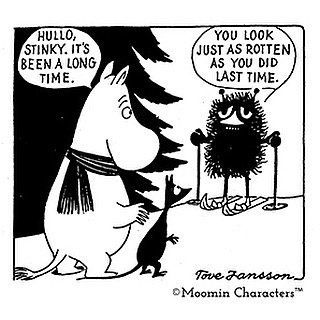
There are also some interesting side characters who come and go throughout the stories such as Mrs. Fillyjonk, an obsessive compulsive mother who lives in strict order, the Groke, a frightening creature that brings winter, the Hemulens, orderly creatures that like to collect, but can be stubborn, Stinky a troublesome, irate character that gets pleasure out of playing practical jokes on others, and the Hattifatteners, which are white mushroom-like creatures that get energy from lightning. Each character in the story has a distinctive personality and while on adventures the friends and family meet other unusual characters, get into challenging situations, and have fun together.
Living the Simple Life, Routine, and a Welcoming Spirit
“I only want to live in peace and plant potatoes and dream!“
Tove Jansson
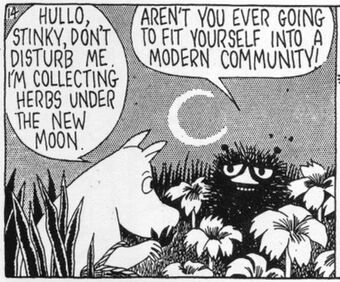
There is no doubt that the Moomins live and embrace a simple life style. Although the Moomin family often go on exciting adventures, all their adventures are focused around nature. For example they go mushroom picking, climb trees, venture onto other islands, and go flower picking. Mushroom picking, flower picking, midsummer festivals, bonfires, escaping to the countryside, and fishing, which are all included in the Moomins’ everyday adventures throughout the series, are typical traditional Finnish activities. As audiences enter the Moomin story, it becomes evident that the Moomins are always centred around family and nature which are both treasured in the Finnish culture. The life in Moomin Valley is very simple: it rotates around the cycle of nature. For example, the characters use nature to be the main source of their entertainment and sustenance and to escape the harsh winters, they hibernate. Similarly, the Finns have a philosophy called mökkielämä, which refers to the cottage life of living slow and in tune with nature. Living in harmony with nature is one of the themes that flows throughout Tove Jansson’s Moomin saga.
The Moomin family often tries to live in harmony with other characters in the valley as well, but this poses to be a bit more challenging since there are so many different personalities. Despite this, the Moomin family is always welcoming and accepting of other families and various types of creatures in the valley despite their differences. The Moonin house is famous for welcoming all different creatures. Unlike Mrs. Fillyjonk, the Moomins happily open up their home as a place for visitors to play and have adventures. This may be one of the reasons why the Moomin family is so loved by others and why characters like Ninny, the invisible child, are able to be free and heal. Ninny came to the Moomin family as an invisible child due to her inability to express her emotions. Ninny was brought up by a cruel aunt and, due to her abusive upbringing, she learned to trap her feelings until she became fully invisible. She was brought to the Moomin family to spend some time with the Moomin family and to perhaps regain her shape. Because of the comfort and love given to her, Ninny started to regain her shape gradually until finally she was able to express her true feelings.
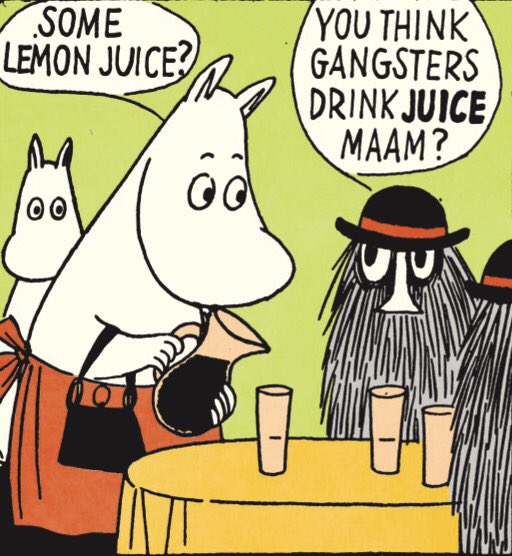
Another theme in Moomin series is adventure versus order. There is a good balance of characters that enjoy adventures and other characters that are stubborn in keeping strict routine and order. Around the Moomin house there is some routine: Moominmama is always cooking and doing house work and Moominpapa is usually sticking to tradition, but despite this, the Moomin house is always up to adventures, opening their home to different creatures, and are open to new things. Although Moominpapa often sticks to his routine of reading the paper and follows traditions, he often longs for something new. One character that hates order and thrives on adventure is Little My, who always celebrates when there is chaos or mischief. She tends to like to do things in her own time and own way. She represents the unconventional lifestyle. For example, she will sit in a coffee pot or swing on the clock pendulum. She is always doing non-traditional things to break up the tradition and routine that is so loved by many of the characters in the series. She is a constant reminder of the importance of breaking routine to enjoy and live life differently.
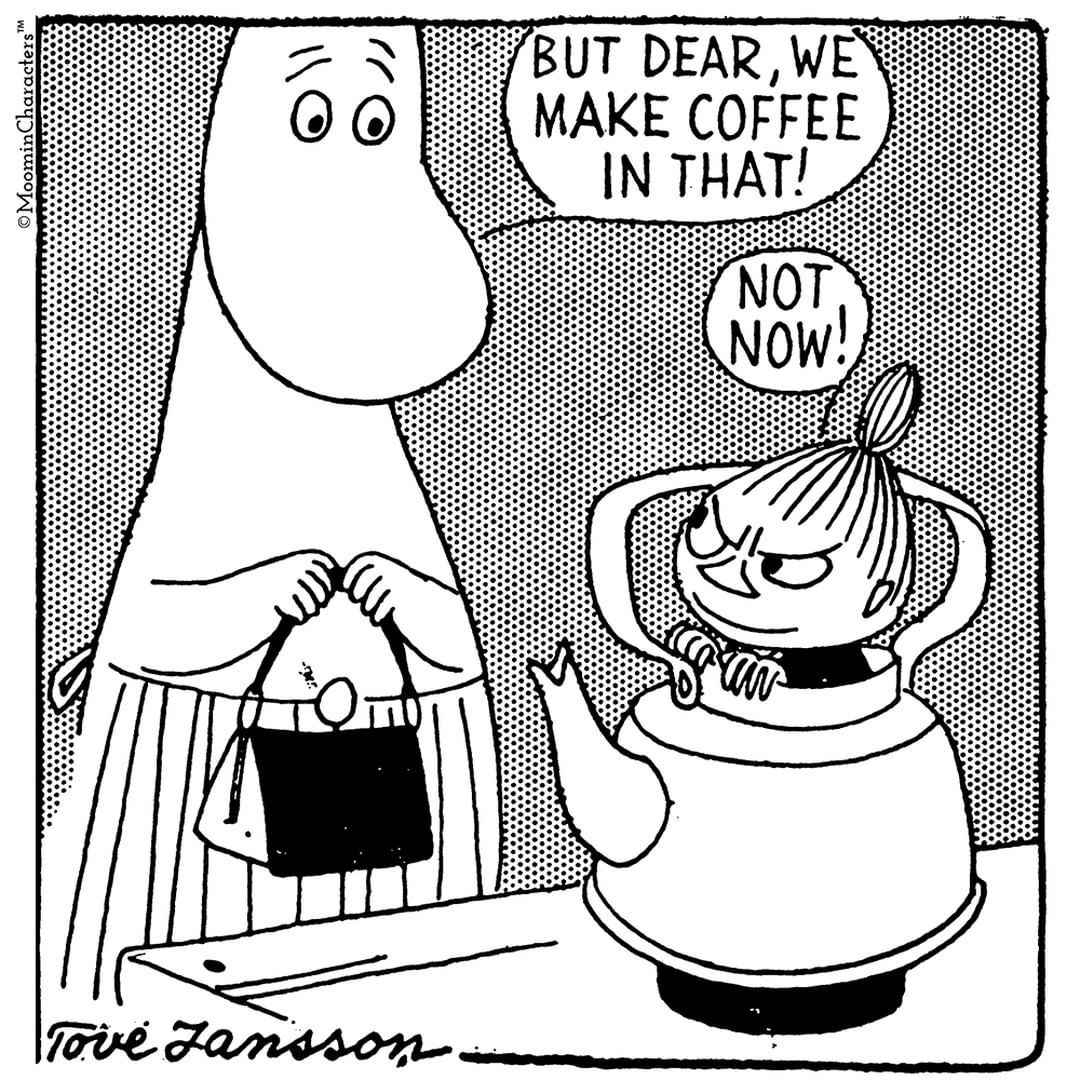
Despite being welcoming to all, the Moomins’ life style is not well received by everybody in the valley. The Moomins’ simple life is often questioned by other characters in the valley. For example, Sniff is always focusing on the material aspects of life and Stinky mocks Moomin for living a simple life style, saying it is behind the times. Despite this, the Moomins never fully understand this “contemporary life” and continue living their simple way of life, having their adventures to entertain them. Perhaps this speaks to why Moomin did not become widely popular all over the world, but became mostly popular and Japan and Finland where the simple life and nature is celebrated and cherished.
Inspired by Nordic Nature
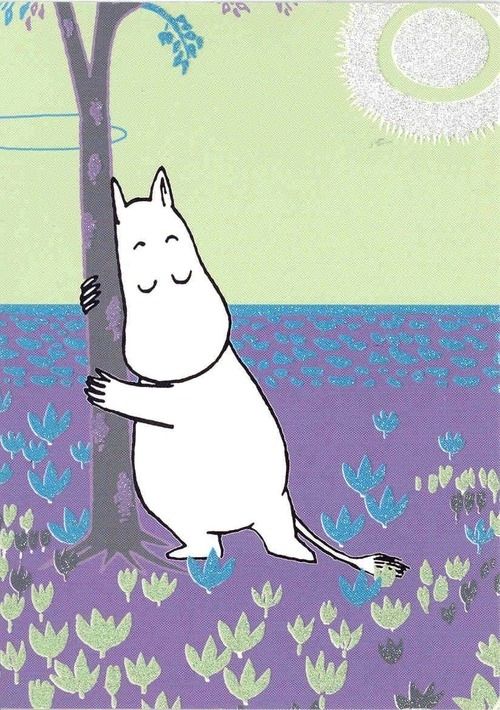
“The world is full of great and wonderful things for those who are ready for them.”
Jansson , Moominpappa
In many ways, Moomin Valley’s nature is designed to mirror Finland’s nature. Moomin Valley is described as a beautiful place full of green pastures, rolling hills, forests, flowers, and wild berry plants, surrounded by mountains in the east and and facing the sea in the west. Tove Jansson was inspired by the nature around her to create Moomin’s world. Brought up by artistic parents, Tove Jansson was raised in Helsinki, but she would go every summer with her family to a rented cottage in a small island off of Porvoo. Finland is famous for its pristine nature, lakes, and well-preserved forests. Finland is Europe’s most heavily-forested country, with 75% of its land area being forest. Because Finland is mostly forest, the the Finnish people have a deep connection with the forest and the forest plays an important part of the Finnish culture and economy. This connection with the forest is seen in throughout the Moomin series as the Moomins spend a lot of their time in the forest. Tove Jansson illuminated the forests in her comics and books by adding a lot of artistic detail to the forests. Although the characters are drawn in a simple manner with few drawing strokes, her forests are drawn with great detail and elaboration with pen and ink .
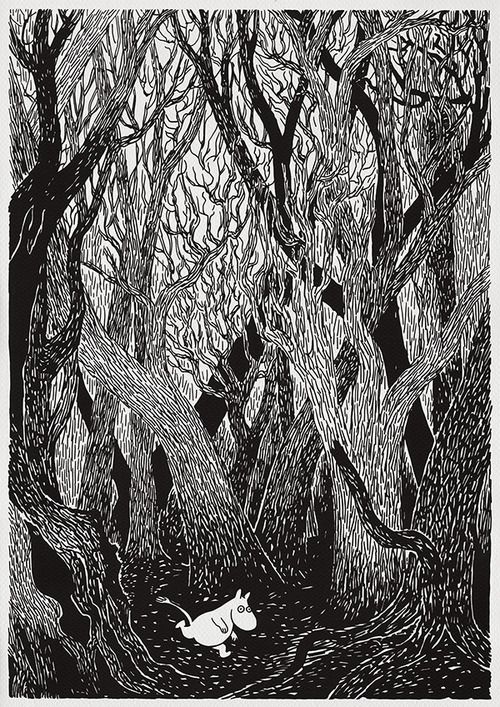
For example in the photo above, one can see how simple Moomin looks comparing to the elaborate gnarled trees. In this manner, Jansson highlights the importance of the forest in the story.

“It’s only the sea,” said Moomintroll. “Every wave that dies on the beach sings a little song to a shell. But you mustn’t go inside because it’s a labyrinth and you may never come out.”
Tove Jansson, Comet in Moominland
Finland is also famous for its numerous lakes and its Baltic seashore, where Jansson spend many summers enjoying the quintessential simplicity that only a traditional Finnish cottage can offer. Such dwellings have few amenities, encouraging people to look to nature as their main source of sustenance and guidance. Having nature as guide, spending time in silence in order to understand nature, and being one with nature is part of the Finnish summer cottage experience. Often summer cottages are by lakes or by the sea. Tove’s love for islands and summer houses is highlighted in the Moomin series as the Moomins adventure off to islands and lakes in the summer. The Moomins are also able to swim and often go to the sea or the lakes during the summers. In the novel, Moominpapa at Sea, Moominpapa goes off to sea to try to understand the sea. The sea presents new adventures, a sense of wonder, and discovery for the Moomin family. Finland’s short summers are well celebrated in the Moomin stories.
Finland’s long winters
“There are such a lot of things that have no place in summer and autumn and spring. Everything that’s a little shy and a little rum. Some kinds of night animals and people that don’t fit in with others and that nobody really believes in. They keep out of the way all the year. And then when everything’s quiet and white and the nights are long and most people are asleep—then they appear.”
Tove Jansson, Moominland in Midwinter
Finland is well known for its long and harsh winters and this is not forgotten in the Moomin series. The Moomins, like many creatures that traditionally hibernate over the winter, hibernate during long winter months. Although some characters temporary disappear during the winters, some characters come only in the wintertime. For example, the feared Groke is creature that brings extreme cold wherever she goes and only comes to visit Moomin valley in the cold months. The Groke has an ominous aura to her and despite never speaking, no one really likes her. She seeks friendship and warmth, but no one gives it her because everyone is too scared to go near her.

“It’s called skiing. It makes you rush ahead fast, like lightning, in a cloud of whirling snow, and you’ve got to look sharp, or else.”
Tove Jansson, Moominland Midwinter
Although the Moomins are typically asleep during the winter, Moomin awakes and partakes in winter adventures in Moomin in Midwinter. Here, Jansson introduces to her audience to the different winter traditions and the allows the audience to explore Finland’s winter nature. Despite the cold, Moomin ventures outside to see what nature is like in the winter. Moomin finds snow covered trees, ice lakes, and dim sunlight. Moomin also meets different characters such as Too-Ticky, a wise winter-loving character that stays up all winter and Lady of the Cold, who brings winter to Moomin Valley. Unlike Snufkin, who always travels south to avoid the cold, Too-Ticky comes to Moomin Valley during the cold months to enjoy the nature’s beauty in winter.

The Lady of the Cold is another mysterious character that enters in the series during Moomin’s winter adventures. Interestingly, Lady of the Cold was not illustrated by Jansson to create a more mysterious character for her. She is spirit-like and feared by many because, although she is described as beautiful, it is told that those who look at her in the eye become pillars of ice. Perhaps, the Lady of the Cold speaks to northern Finland’s icy temperatures.
Life Philosophies, Dark Humour & Hope
“A theatre is the most important sort of house in the world, because that’s where people are shown what they could be if they wanted, and what they’d like to be if they dared to and what they really are.”
Tove Jansson
Along with reverence to nature, the Moomin stories are filled with life philosophies and characteristics of the Finnish people. Although Jansson wrote the Moomin stories for a younger audience, the Moomin stories are filled with deep life philosophical themes and appeal to people of all ages. Life themes such as friendship, change, and the importance of confidence and curiosity, are weaved throughout the story. Despite at first glance appearing to be simple children’s stories, the Moomin stories are quite deep and touch upon core themes of humanity. For example, although the Groke is seen as a frightening “villain” on the surface, she is a character that reminds the audience that people can be different and that even the most welcoming places can exclude people. The Groke constantly tries to visit Moomin valley to make a friend, but is never received well. The Groke can also represent personal fears that “freeze” one from pursing dreams or going outside of one’s comfort zone. Below is the Japanese animated version of the Groke. Her musical theme expresses a lot about her timid, sad, and eerie character.
Despite the Moomins living in a peaceful valley that is centred around joy and simplicity, they are not unfamiliar to tragedy. The Moomins face many different hardships such as fleeing storms, floods, volcanos, and even a comet. Despite all this, the Moomins learn to persevere and learn from the hardships each time. In fact, one of the main themes in the Moomins is learning through misfortunes. Tove Jansson created the Moomin story during World War II. In her childhood, she faced the horrors of living through the war. In an article published the University of Jyväskylä, Heinämaa, a researcher in literature and philosophy, points that “recurring themes (in the Moomins) include the destruction of one’s home, orphanhood, homelessness and migration. All these things are part of Finnish history of past decades, but for many they still belong to the present.” Jansson used an imaginative and lighter hearted story to touch the Finnish peoples’ hearts and to reflect Finland’s story. Despite the hardships, the Moomins are full of hope and resilience.
“But one needs a change sometimes. We take everything too much for granted, including each other.”
Tove Jansson, Moominpapa at Sea
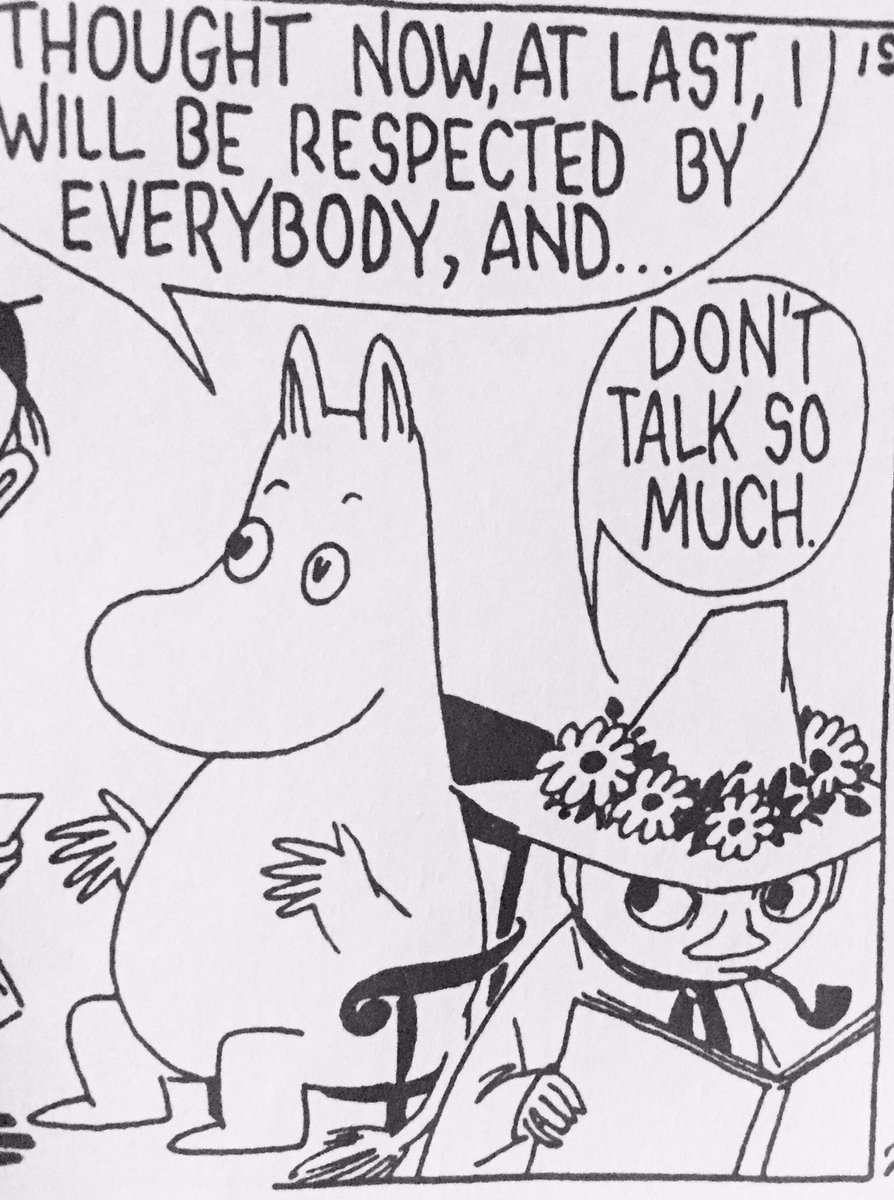
In addition to bringing messages of hope, the Moomin stories and comics hint at some characteristics of the Finnish people. Solitude and silence is a theme that continues through the series. The Finns are well known for speaking little and taking each word they say seriously. Small talk is not well praised and every word said is supposed to be said with meaning and truth. This is subtly noticed in the series as the characters do not say too much, but every word is meaningful and well placed. Despite this, some characters tend to ramble more than others, and as the above comic shows, these characters are reminded to keep quiet. Silence is also important and considered sacred. In the comics, it is seen that being silent and engaging in an activity such as picking flowers or going fishing is used to calm characters down and to spend time with each other. If one looks carefully, it is also noticed that the Moomins have little detail for a mouth. They have large snouts, but no detail for lips. Perhaps the Moomins speak with their mouths closed. The ambiguous mouth also limits the amount of facial expression the Moomins can show on their face.
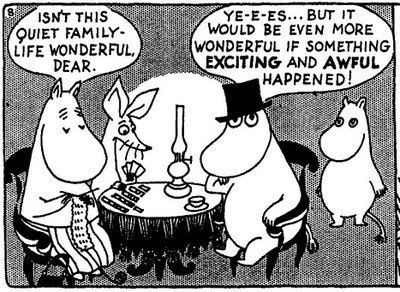
Although being a mostly light hearted series, the Moomins do not refrain from presenting things as they are even the dark and ugly. The Moomins seem to welcome “awful” and “miserable” things in their lives. It has been generalized that the Finns are generally serious people, but of course they enjoy humour. Finnish humour can be dark at times. This is something that may through off many when reading the Moomin comics.
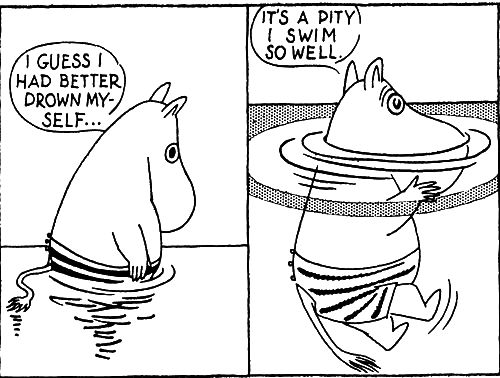
Despite the few darker comments here and there, the Moomins accept the good and bad in life and always make the best out of it. In a way, the Moomins do not sugar coat anything. This makes the Moomins relatable even though they are imaginative creatures.
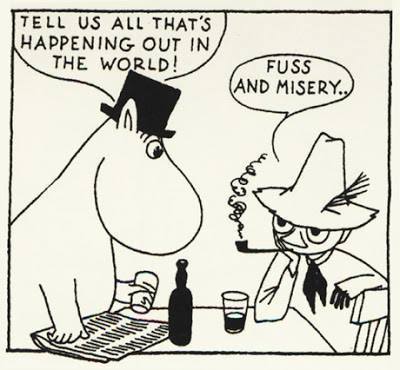
Legacy of the Moomins

Loved by many around the world, the Moomins teach everyone to embrace the simple things of life, to have hope, to always stay adventurous, and to spend time in nature. Because of her Moomin creations, Tove Jansson became a famous Finnish artist and author. Perhaps Moomin did not become as popular as Walt Disney’s Mickey Mouse, but Moomin has a culture and story to share. Tove Jansson did not seek popularity when creating Moomin; in fact, Walt Disney offered Jansson the chance to sell her characters to Disney, but she turned the offer down in order to retain full creative control. Despite this, the Moomin stories have been translated into fifty languages and because of popularity of the Moomin’s stories, Jansson has become one of the most well-known Finnish artists and writers. The Moomin legacy continues to live on with cafes, theme parks, and a new television series that just started airing in 2019. Coming from Finland and written during the wake of World War II, the Moomins show the world little snippets of the Finnish culture and character as well as reminding the world to take a step away from the busy life to enjoy the simple things once more.
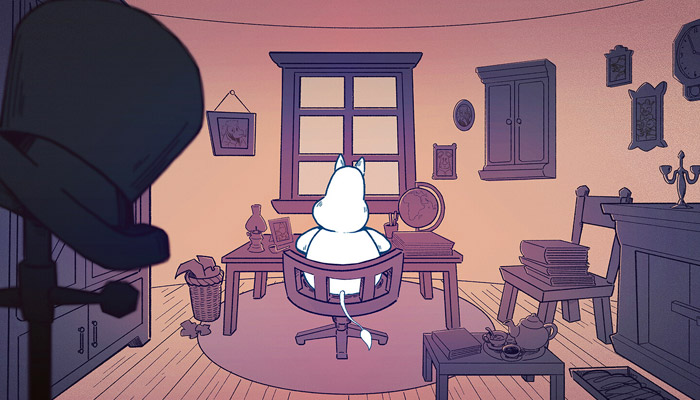
What do you think? Leave a comment.











I am in love with your article.
I was first introduced to the Moomins by my primary school teacher, Miss Simpson. I was a shy, fat, camp, bookish misfit of a child… she was amazing…. all open necked shirts and flares and big Leo Sayer curly hair (it was the mid-70s) anyway… I was given Moominland Midwinter to read and was totally entranced. I think in lots of ways they were my first introduction to what I would now recognise as a queer sensibility.
They are beautiful, beautifully written and beautifully illustrated. I think, especially those that have not read the books, people often miss how emotionally intelligent they are. Yes – they are cute and fun, but theres an emotional realness in there. I always loved the Groke, and the Hattifatteners. And Too Ticky!!! The later books get so dark… Moominpapa at Sea and Moominvalley in November really do deal with loss and longing and all kinds of very adult themes. Theres also the joy of the family – and the created family in the books is so accommodating. Years later I went on to create my own family, in my own way and as a gay parent I still kind of felt that these books in some very childlike way reflected my own children’s lives back at them. Thank you Tove – always. And thank you Miss Simpson for being a hero to me as a small scared gay boy and recognising where something gentle might help!
Such a great story about Miss Simpson. And, I love your review of the books themselves.
Here in Finland, Tove had always been a gay icon: strong in her character and sense of righteousness, fairness and tolerance. Her partner, Tuulikki Pietilä, was also a celebrated artist. They lived “extended summers” together on a small remote archipelago island called Klovharu. It is open today for anyone to visit, as long as you have the right kind of boat.
Now isn’t that funny? Moominland Midwinter was my first book, all to myself, that my mother bought me. It became far more pervasive in my nascent world than, say, Ronald Dahl’s books, which are without doubt excellent, but I don’t have copies of them on my bookshelves all these years later. I do of Tove Jansson! Now the odd bit is this: I was always a queer kid. I mean that in the every sense of the word! In time I did indeed become a gay adult. Obviously I knew Tove had been too. But until I read your post I had never really picked up on how this might have informed the aesthetics and sensibilities of her books. Nor for how this might have impacted on my own childhood intuitions and later gay identity. Of course, Jansson’s books aren’t just concerned with or read by one group or identity but still your post gave me a startle of recognition. I shall have to go back and reread them again!
Thank you – a lovely post.
I read the books as a child as well as being in love with the beautiful stop-motion, Richard Briers narrated animation of it and I still read them now. I think they’re perfect. I ask myself, what would Snufkin do or what would Moominmamma do in difficult or problematic situations. I relate people to their appropriate Moomin character, I try to make my world as much like Moominvalley as I can. I genuinely think the Moomins are a philosophy and there is much we can learn from them, and I think that was at least part of Tove’s intent. Every bit of praise and recognition she gets, she deserves. She’s my favourite artist and favourite writer, absolutely just love her. I am really excited about this new series.
I live in Japan and I can confirm Moomins are huge in Japan. There are Moomins cafe where one can enjoy the company of huge soft toys after the characters of the animation! Very popular not just with kids but with teenagers! Got the entire collection in Japanese that my kids regularly watch and rewatch. This is deliciously weird with an animist twist as the forces of Nature are incarnated in various spirit-like creatures. I have the feeling that this is part of what might resonate with Japanese.
Yes I have heard that Moomin is popular in Japan ! Thanks for sharing
Hardly surprising. No doubt they’ll rip it off like they did with Miffy and sell it back to us as some strange superflat bear thing.
I once had a Moomin pencil case from Japan – it was one of the best presents I ever got.
Whenever you find yourself in a difficult situation ask yourself: “What would Moominmamma do?”
A film about Tove would be excellent.
The BBC did “Moominland_Tales-Moominland_Tales_The_Life_of_Tove_Jansson”
A documentary. In fact, here it is:
https://www.bbc.co.uk/programmes/b01pgrk2
There’s also a number of BBC radio pieces: Short stories, maybe, I can’t remember.
There’s actually one on the way.
https://www.youtube.com/watch?v=dW46F5zP0V4
The moomins books are the best children’s books ever written. They’re wise, strange, funny, incredibly emotionally real and they’re right about everything.
When I read them to my son I was enraptured. If he hadn’t wanted to continue until we’d read them all, then the comic strip and the picture books I would have been a little disappointed in him as a person and I would have continued reading on my own.
If you haven’t yet, read them to your children. If you haven’t children, read them yourself.
“Wise, strange, funny, and emotionally real.” That’s a compelling review right there. I think some American children’s authors can do that, but they’re a little too afraid of the “strange” and “real.” I wish they weren’t; kids like strange things. Heck, so do adults. And it is in the strange and emotionally real that we find–well, real things.
I had never heard of Moomin before, but his stories sound lovely. In such a Disney-fied world, I love the idea of other cultures having characters and creatures that are just as popular and beloved as Mickey Mouse. I also like the idea that some Moomin characters, like Stinky and Little My, can have negative characteristics like being materialistic or naughty on purpose, and the “moral guardians” don’t seem to be freaking out about it.
It’s great to see this article published. I really enjoyed helping in the editorial stage. Such an enlightening view on a culture that few are even aware of. How wise of Tove not to sell out to Disney – we can only image what horrors would have resulted had she relented – so Moomintroll, family and friends have retained their unique identities. I’m going to recommend this article to several friends. We have a lot to learn from Fins (other than how to be the best rally drivers in the world;)).
Snufkin is my creepy spirit guide. He never tells me what he’s packing in his pipe.
I always liked that frame with Moomin Papa asking Snufkin to tell him all that is happening out in the world
“Fuss and misery” he replies.
I grew up as a child on these books, the greatest influence on me of any factor, and Snufkin was my greatest character – the mysterious world he goes into, that he does not talk of, but must go to. I wanted to be him from the start, going over the hills to places no one knows of.
I loved the Moomins as a child, but the hattifatteners freaked me out and still do – something about an army of whispering condoms shuffling across the landscape makes me uncomfortable.
The Moomins wouldn’t stand a chance:
1,the Clangers are far more tribal
2, the one in charge is named ‘Major Clanger’ which suggests some kind of military career/combat experience.
3, they’ve got a literal dragon and ‘Iron chicken’ fighting in their corner
Oh my. I didn’t know anything about this! It will be my reason to be cheerful for the foreseeable. Utterly brilliant works. Everyone should know about Moominvalley. Oh my.
My 50th this year and I was asked what I wanted by my parents, a complete set of Moomins from them is about as perfect a present as they could get me
I would also ask for some Alan Garner too, but before he got all grim, his more uplifting like ‘The Weirdstone of Brisengamen’. Maybe even ‘The Midnight Folk’ books by John Masefield.
Living in Finland as I do, it’s clear to me the so-called Finnish education miracle is down to a combination of Moomins and the Finnish language. We happen to have both the English and Finnish version of a Moomin book for preschoolers to help our children with both languages.
In the English version there is a picture of Moomintroll at the beach picking up some shells and in big letters on the other side it says ‘Shell’.
In the Finnish version it has the same picture but the word the Finnish preschoolers have to learn to read and say is ‘Simpukankuori’. I struggle with that and I’m in my 40s!
As a Finn, I should say that it is much easier for us to learn to read than for English speakers. Yes, our words can be terrifyingly long, but it is all phonetic – one letter always corresponds to the same sound! I have worked as a teaching assistant in primary schools in England, and it amazes me that kids learn to read at all when there is such a divergence of the sound a particular letter makes. It definitely seems to me that much more time needs to be spent for kids to learn to read than there needed for us.
The Groke is one of the single most terrifying creations in literary history. Damn thing terrified the life out of me as a child.
Comet in Moominland was one of my favourite books as a child, and it’s been a joy to read it (and the others) to my children as they have grown up.
Something about its mysticism, the perilous journey to the observatory and even more perilous return, across the bed of the dried-out sea as the comet approaches, was (and is) so amazingly evocative.
It somehow gave me a deep feeling that one could take risks in life, even as a child, and everything would turn out ok.
Tove Jansson was a genius.
Yes, my favourite as a child was Comet in Moominland too. I loved the journey across the sea bed. I still read them now and again as an adult and there is a richness and depth to them that I can enjoy.
Personally I can’t stand the Moomins. Thought they were as dull as dishwater growing up in the 70s and 80s, and after being married to a Finn for over a decade I find them consistently tedious.
One question no Finnish person seems to have a logical answer for – Moomin Papa goes about his day to day business billy-bollock naked, barring his top hat. However, when he goes swimming he puts on a full length swimming costume. Why?
You might not yet have reached the right age to read the books, especially Comet in Moominland. We bought a copy of that book in German for a daughter of a friend of ours, when she was aged 10. She was upset about receiving such a childish book! Her mother told us a few years later that her daughter only “discovered” the book when going through a difficult puberty and its dark tone suited her angst-ridden soul.
I haven’t heard of these little guys before but after reading this I am very intrigued to learn more!!!
My husband – who is a Finnphile – introduced my kids to the Moomins. Must say I’d never heard of them growing up. The kids love them – mind you my daughter is almost 14 and son 16 now!!
I loved the Moomins as a kid. Read them to 3 of my 4 children. Only the youngest proved strangely immune. I hope she discovers them when older. Moominsummer Madness with the floating theatre is my favourite.
There was a recent wonderful BBC4 documentary on the golden age of post-war kids’ TV (roughly the early 60s to the mid-80s) which featured the Moomins amongst much else. This was a time when a collective ethos of storytelling, creativity and educativepublic service really informed children’s TV. Basically, the government just gave lots of money to what seemed to be mainly a load of ex art-students to do what they liked, and it really worked. Being born in the late 70s, I missed most of this – but remember frequent re-runs of the Moomins as well as the tail-end of wonderful children’s drama (Chocky, The Box of Delights).
Go to Finland regularly to see family and recently stayed in the building Jansson grew up in. The Moomin shops are particularly popular with Japanese female tourists as they are very ‘kawaii’ to them but to the Finns they represent ‘sisu’ (determination and hardiness) and characters with weird darkness too and love of nature. Bit like the Finns. Love to go there and see metal as a mainstream teenage culture and Finland has changed. People aren’t so famously taciturn as much but they used to but they still do Saunas the best: our grandchild just had his first session at five months! Just never never compare them to Russian banja steam baths. You’ll be looking at a deadly frown if you do.
I’ve always wondered about the Moomin stories as it’s been popping up on my radar a lot for the past year or so. People on the cottagecore side of Tumblr are really into it and I can see why. The messages of getting in touch with nature, enjoying the simple things, and seeking adventure when bored could not be more timely. Thank you so much for this detailed essay. It really covered everything! Moomin is such an underappreciated character and series, but I respect Tove Jansson so much for not selling out to Disney. It’s been able to keep the core messages and themes from its inception, and while many don’t know about it, I can say for myself now that I’ve learnt about it I love it and I value Jansson’s vision so much. I also really enjoyed learning about Finnish culture–I had not idea Moomin was a Finnish creation. I can totally see why Japanese culture grabbed onto it. A follow-up article on the Japanese influence on or embracement of Moomin would be great to see.
Always been a fan of the Moomins. Have been reading the stories to my kids.
Just wanted to say that everyone who likes moomins should read the summer book by Tove Jansson. Really touching and deep despite the apparent simplicity of the stories!
Since a young age I fancied myself as a sort of Snufkin.
I hadn’t realised that Moomins and the Great Flood was the first book; I always thought it was Comet in Moominland. I’ve read that one dozens of times, and Finn Family Moomintroll, but always struggled to get into the later ones although Moominpappa at Sea was always grippingly bleak.
I’ll save them up for my 3yo. Struggling to keep her away from cartoons like Peter Rabbit that suck all the charm out of the originals. I had to go for a brisk walk the other day on my own when I saw her being read Winnie the Pooh – but a book based on the Disney adaptation. Banal, devoid of charm and just pointless.
I still want to visit the observatory, collect garnets and hide from the Groke.
I loved these books as a child- Moominland Midwinter being my very favourite. A fantastic series.
I’ve got fond memories of the books as a kid, a mixture of cosiness and scary weirdness and creeping melancholy. So much so I occasionally revist them; plus they led me in later life to Jansson’s adult stuff like Summer Book and Winter Book.
I loved the animated series that I watched as a child and the books. Both were dark, yet comforting; they were like fairy tales of old, not too sugar coated.
I recently saw an updated version of the Moomins and it was a sterilised pile of fluffy crap. Gone were the slightly sinister elements, now it was Disneyfied and polished. Yuck.
Lovely stuff. For anyone wanting to understand why people love these books, please check out the episode of the wonderful Backlisted podcast on which the equally wonderful Frank Cottrell Boyce talks about Moomins in Winter. Magical and joyful.
Thank you, I wasn’t aware of these podcasts – lots of good stuff!
I was delighted when a colleague at work admitted to a loving of Moomins, so I admitted to my own enjoyment of the books as a youngster and later the lovely German/British Cartoon series. Then she admitted she was brought up on the pap, cutesy cartoon series that the Americans foisted upon us & I decided it was better not to mention it again.
As a child the Moonins always left me wishing Barbabpapa was on instead, in the same way Noggin the Nog always left me wishing Ivor the Engine was on instead. Although I’d have taken either over Ludwig.
What a well-written and thorough article! I love learning about cultural icons and mascots, and what they say about the cultures they come from. I especially love the cute ones!
Simply one of the great peaks of children’s literature.
My 4 month old is called Noomi. We occasionally call her Noomin Troll. It makes us very happy. I have nothing more constructive to add.
The Scandinavian TV series from the 70s was outstanding. Many, if not most, Scandinavians now remember Moomins because of that series.
Pity I haven´t seen it. The japanese tv-version from 90´s was really horribly in my opinion. I really suffered seeing my yongest sister watching it, having read the books and comics in 70´s and living on my own at the time my sister was about 5 etc.
Not my most original comment but I had never heard of the Moomins before, and now I look forward to the chance of reading the stories! So, thank you!
How did you discover Moomin? Are you Finnish yourself?
Hello! No worries– I actually travelled to Finland last summer so I saw them all over the place there. I have a Finnish friend and a professor from my university was from Finland and she used Moomins in her book.
Had been eagerly waiting for this article to go live ever since I discovered it to be ‘Locked’ in the publishing queue. One of the most informative articles I have come across on the platform as it introduces a not often talked about lovable character to a wide audience. Great work! Would love to read more articles from you.
Thank you so much! So happy you enjoyed my article. Looking forwards for articles from you too 🙂
This stuff gives me the creeps. Always has since I was a nipper.
A Swedish-speaking Finnish teenager introduced me to the Moomin books. They seemed to have a special resonance for her. Many years later she settled down with a woman as her partner. Presumably Tove Jansson as a role model played some part in easing that path for her.
Much of the impression of Moomin evokes two American comic strips: Peanuts and Pogo Possum. Peanuts, among the most famous strips in the world, shares with Jansson’s creation a tone of measured cynicism. Both strips embrace humor than often deprecates one or more characters while offering both the promises and treacheries of life. Pogo Possum, like Moomin, has cutesy character designs that offset the political and social critique at their respective cores. Pogo had many plots that addressed the political issues of the 1950s and 60s (notably the Red Scare), while you’ve shown how, though in more subtle ways, Moomin encapsulates sentiments of being aware of one’s environment, a very pertinent issue in this era of accelerated climate change.
If make sense to me how Moomin never took off in the States the way it has in its native home and Japan. Aside from aesthetic differences in design, the American media landscape doesn’t embrace cartooning and animation that avoids superficialities and embraces a greyer tone. Thank you for your insightful article!
An interesting essay.
A textbook example of a work for all ages that deftly depicts mature themes and social commentary without ever losing its enchanting and hopeful touch.
Such a lovely walk through the Moomin universe, and Finnish tradition, nature, and culture! A highly enjoyable read that carries the tender, light tone of the Moomin stories through the prose used to detail the nature of Jansson’s work. I am second-Generation Finnish-American myself, and so while I have grown up with the image of Moomin (though not the English-translated words), this piece contained a lot about the Moomin I did not know before. The ruminations on Finnish culture felt so home-like, nostalgic, and warmly familiar to me. Simply lovely!
Thank you for this – what a lovely read!
I’ve grown up with the Moomins and they bring me so much joy. I absolutely love the dark humour, my favourite story is their trip to the French Riviera.
Tove Jansson also wrote fantastic prose for adults – her short stories are some of my favourites, I highly recommend them.
What a lovely article!
Thank you for this insightful description of Moomins and their world and how it relates to Finnish culture.
Being unfamiliar with Moomins, I didn’t appreciate them when we were in Helsinki last spring. I did buy a Moomin dress that features Little My, which I love and wear often.
>Perhaps this speaks to why Moomin did not become widely popular all over the world,
That’s because the 1969 and 1972 versions were only aired in Japan. Even in Japan, rebroadcasting was not allowed. Therefore, Moomin’s popularity lacks global reach. If the 1969 and 1972 versions had been broadcast around the world, Moomin might have become more famous than Mickey Mouse.